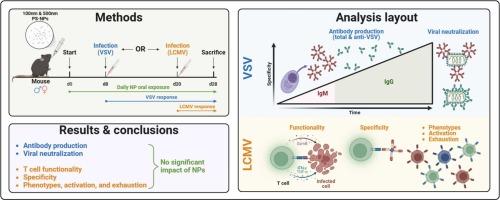Short-term oral exposure to nanoplastics does not significantly impact the antiviral immune response of the mouse
IF 12.2
1区 环境科学与生态学
Q1 ENGINEERING, ENVIRONMENTAL
引用次数: 0
Abstract
The increasing prevalence of nanoplastics (NPs) in the environment, particularly polystyrene (PS) nanoparticles, raises concerns regarding their potential impact on human and animal health. Given their small size, NPs can cross biological barriers and accumulate in organs, including those critical for immune functions. This study investigates the effects of short-term oral exposure to 100 and 500 nm PS NPs on the adaptive immune responses during viral infections in vivo, using vesicular stomatitis virus (VSV) and lymphocytic choriomeningitis virus (LCMV) as models. Male and female C57BL/6 mice were orally exposed to PS NP for a period of 28 days, during which they were infected with either VSV or LCMV to study the humoral and cellular responses, respectively. The humoral responses were assessed by measuring total and VSV-specific antibody levels, and splenic immune populations. T cell phenotypes, activation, exhaustion and functionality towards LCMV epitopes were studied as readouts of the cellular responses. Our results demonstrate that short-term NP exposure does not significantly affect the generation or neutralizing capacity of antibodies against VSV, nor the cellular responses directed against LCMV. These findings indicate that, under these conditions, PS NP exposure does not significantly compromise the adaptive immune responses during viral infections, underscoring the value of in vivo models.

短期口服纳米塑料对小鼠的抗病毒免疫反应没有显著影响
纳米塑料(NPs)在环境中的日益普遍,特别是聚苯乙烯(PS)纳米颗粒,引起了人们对其对人类和动物健康的潜在影响的关注。由于它们的体积小,NPs可以跨越生物屏障并在器官中积累,包括那些对免疫功能至关重要的器官。本研究以水疱性口炎病毒(VSV)和淋巴细胞性脉络丛脑膜炎病毒(LCMV)为模型,研究了短期口服100和500 nm PS NPs对体内病毒感染过程中适应性免疫反应的影响。将雄性和雌性C57BL/6小鼠口服暴露于PS NP 28天,分别感染VSV或LCMV,研究其体液和细胞反应。体液反应通过测量总抗体和vsv特异性抗体水平以及脾免疫群体来评估。作为细胞反应的读数,研究了T细胞表型、激活、衰竭和对LCMV表位的功能。我们的研究结果表明,短期NP暴露不会显著影响VSV抗体的产生或中和能力,也不会影响针对LCMV的细胞反应。这些发现表明,在这些条件下,PS NP暴露不会显著损害病毒感染期间的适应性免疫反应,强调了体内模型的价值。
本文章由计算机程序翻译,如有差异,请以英文原文为准。
求助全文
约1分钟内获得全文
求助全文
来源期刊

Journal of Hazardous Materials
工程技术-工程:环境
CiteScore
25.40
自引率
5.90%
发文量
3059
审稿时长
58 days
期刊介绍:
The Journal of Hazardous Materials serves as a global platform for promoting cutting-edge research in the field of Environmental Science and Engineering. Our publication features a wide range of articles, including full-length research papers, review articles, and perspectives, with the aim of enhancing our understanding of the dangers and risks associated with various materials concerning public health and the environment. It is important to note that the term "environmental contaminants" refers specifically to substances that pose hazardous effects through contamination, while excluding those that do not have such impacts on the environment or human health. Moreover, we emphasize the distinction between wastes and hazardous materials in order to provide further clarity on the scope of the journal. We have a keen interest in exploring specific compounds and microbial agents that have adverse effects on the environment.
 求助内容:
求助内容: 应助结果提醒方式:
应助结果提醒方式:


